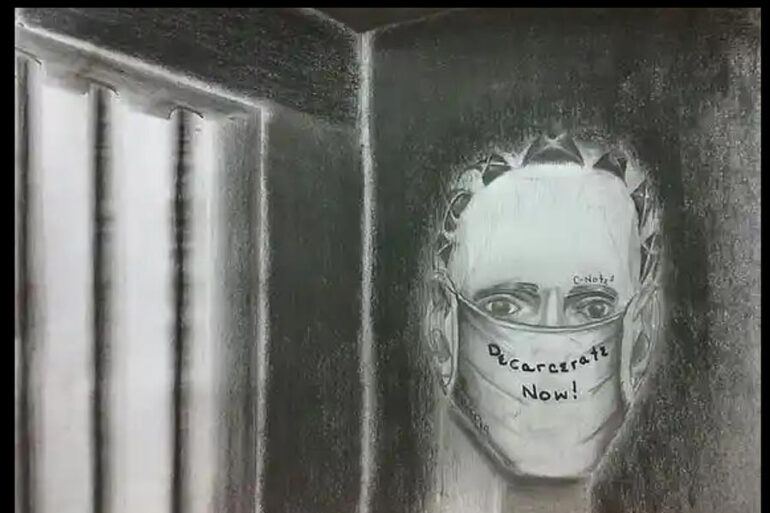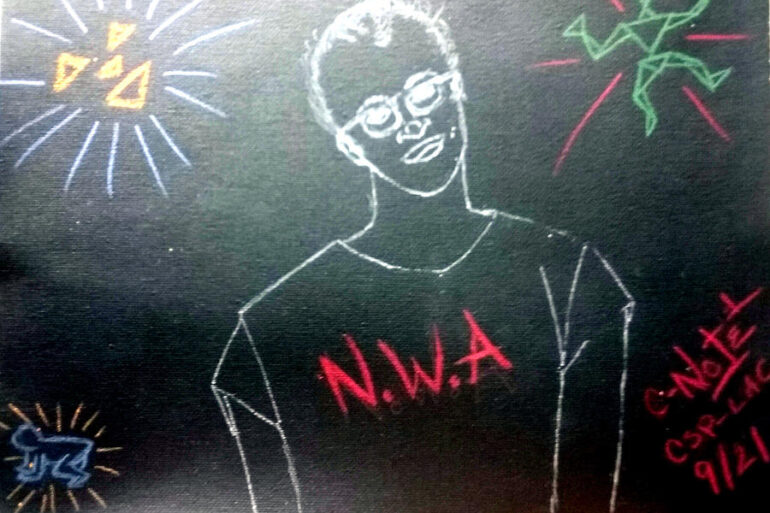Description
October 20th - 23rd 2021, was the 13th Annual International Prisoner's Family Conference. This year's conference was virtual. Topics included civil rights don't end at the prison gates, prison reentry, children of incarcerated parents, prison wives, and other topics. It also included a Facebook art auction of Prison art. C-Note donated a work to the conference that was specifically created for the event.Man in the Mirror, 2021, 9 in. x 12 in., Acrylic on canvas, Donald "C-Note" Hooker, features a prisoner looking at himself with a handheld mirror. What the mirror reflects back, it's not his image, but an image of him, his wife and child.
Description
October 20th - 23rd 2021, was the 13th Annual International Prisoner's Family Conference. This year's conference was virtual. Topics included civil rights don't end at the prison gates, prison reentry, children of incarcerated parents, prison wives, and other topics. It also included a Facebook art auction of Prison art. C-Note donated a work to the conference that was specifically created for the event.Man in the Mirror, 2021, 9 in. x 12 in., Acrylic on canvas, Donald "C-Note" Hooker, features a prisoner looking at himself with a handheld mirror. What the mirror reflects back, it's not his image, but an image of him, his wife and child.
Description
October 20th - 23rd 2021, was the 13th Annual International Prisoner's Family Conference. This year's conference was virtual. Topics included civil rights don't end at the prison gates, prison reentry, children of incarcerated parents, prison wives, and other topics. It also included a Facebook art auction of Prison art. C-Note donated a work to the conference that was specifically created for the event.Man in the Mirror, 2021, 9 in. x 12 in., Acrylic on canvas, Donald "C-Note" Hooker, features a prisoner looking at himself with a handheld mirror. What the mirror reflects back, it's not his image, but an image of him, his wife and child.
Description
C-Note on Haring is a work of Wax on canvas. It was created to pay homage to his fellow artivist working in the underground art scene. Haring who died of AIDS complication at 31 in 1990, established the Keith Haring Foundation. The foundation's mandate is to provide funding and imagery to AIDS organizations and children’s programs. It also is to expand the audience for Haring’s work through exhibitions, publications, and the licensing of his images. After his death, the Contemporary Art World had become interested in Graffiti, and his Work have been given several international retrospectives.
Description
"Journey to Afrofuturism," is the title to a poem wrirren by American prisoner artist, Donald "C-Note" Hooker. He wrote the poem for the 30th Celebration of African American Poets and Their Poetry at the West Oakland Public Library in 2020. One of the themes to the event was the 400 years of African Americans in California. Upon research, C-Note had discovered that Spanish conquistador, Hernán Cortés, and Governor of Mexico, named California after a Black woman, the Califia to the land of Black women. The poem brings back the Califia to our current times, as the nursemaid to the Afrofuturism movement. Afrofuturism, according to Jamie Broadnax of Black Girl Nerds, is the reimagining of a future filled with arts, science and technology seen through a black lens. The term was conceived a quarter-century ago by white author Mark Dery in his essay “Black to the Future,” which looks at speculative fiction within the African diaspora. C-Note, who is also a poet, playwright, and performing artist, wanted to tell his poem in paint.
Description
. A picture out of a magazine. But I’m not confident as an artist so I don’t want people to compare my finished product to the model or image that I used. I called it “Colored Girl.” I think it fits. It’s clearly a coloration of something, of a woman. But the word “Colored,” though it is a pejorative today, was once known as the desired description that African Americans prefer to be described as. “Colored,” “Negro,” “Black,” these were all terms that African-Americans themselves demanded of the press and white audiences; this is what you call us. An example would be W. E. B. Dubois NAACP. It was originally called the National Negro Committee. Booker T. Washington and other famous black activist before him, demanded that whites call us “Negroes.” So three years after founding the National Negro Committee, W. E. B. Dubois change the name to the National Association for the Advancement of Colored People. That’s proof enough that blacks demanded that they be called “Colored.” So “Colored Girl,” what is that? Any black girl, and that’s pretty much the response that I have gotten from this piece.









